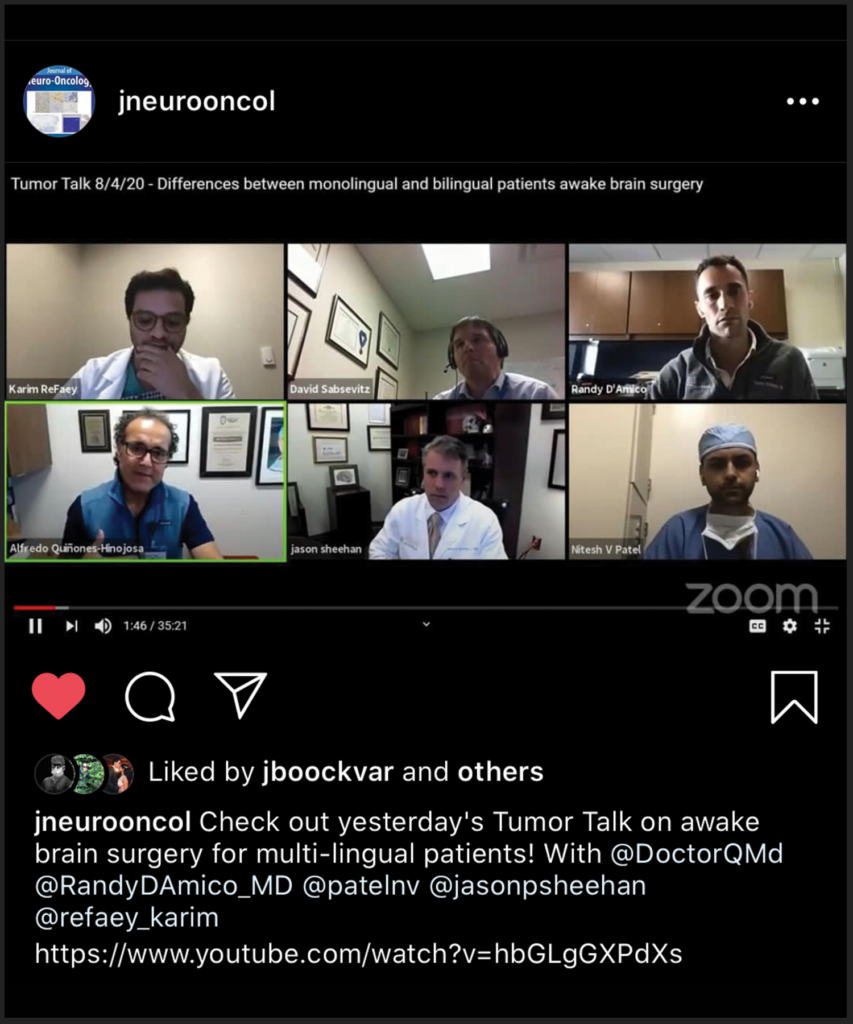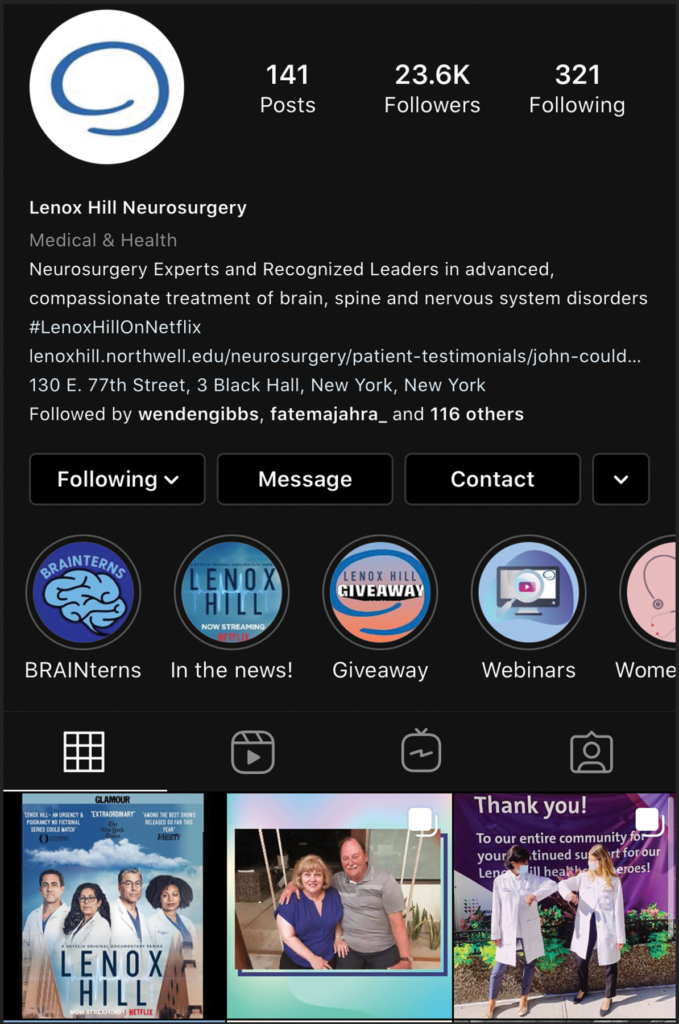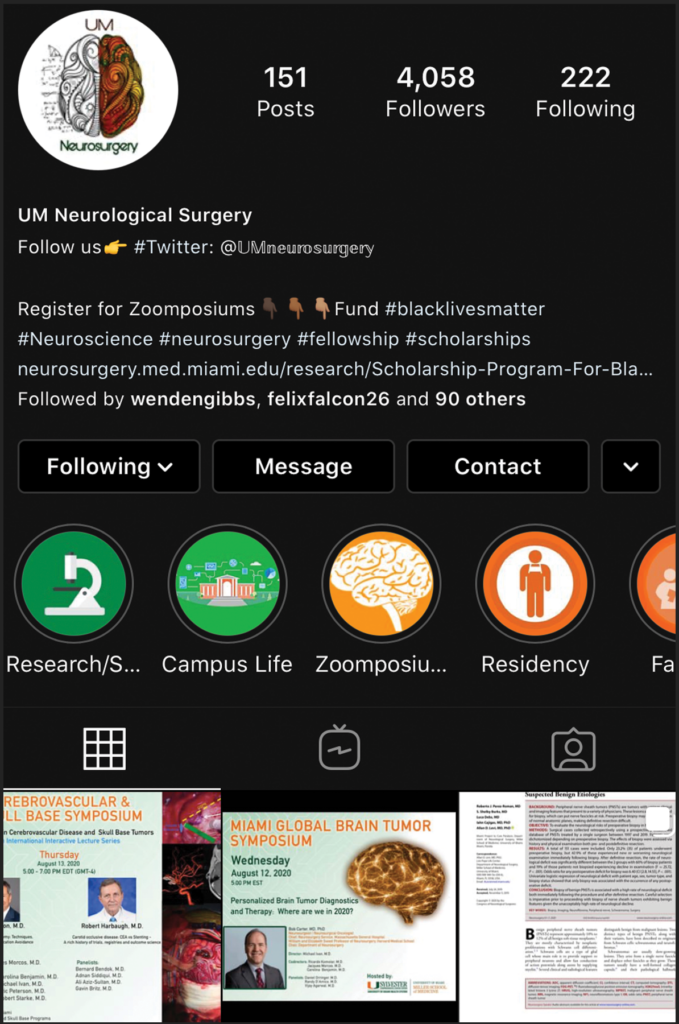Twelve months ago, no educator would have predicted that social distancing guidelines would change the way we train and educate. Even the most basic weekly case conference, a standard in any residency curriculum, has been transformed into an entirely web-based experience. This change has triggered a neurosurgical educational renaissance – an explosion of creativity, a birth of new connections and a breakdown of geographical boundaries.
Meeting software, such as Zoom (Zoom Video Communications, San Jose, Calif.) and WebEx (Cisco, Milpitas, Calif.) amongst others, have facilitated the real time creation and dispersion of educational content. Social media platforms, like YouTube, Instagram, Twitter and Facebook, and individual departmental websites have facilitated an everlasting archive of content. The access count of this content is often measured in thousands at minimum – especially on social media platforms where users can quickly view, engage and re-share.
The availability, ease of use and potential reach of these technologies has prompted many neurosurgical departments to challenge the antiquated and isolationist “classic” ways of education and promote educational content online. In addition to providing high-quality, cutting edge expert-derived educational content, web-based platforms provide the unique opportunity to expand viewership to those outside of the medical field and promote institutional abilities and philosophies. Furthermore, this content is more often being viewed from outside the U.S. than inside. Allowing access internationally to some of the most innovative and most successful neurosurgeons will only help to elevate us all to new levels and inspire us all to push boundaries in the field of neuro-oncology.
In the world of surgical neuro-oncology, collaboration has always been a central pillar. The American Association of Neurological Surgeons/Congress of Neurological Surgeons (AANS/CNS) Section on Tumors has been a flagship of the field. Through the efforts of various members, the educational offerings across various online platforms have been able to maintain a continuity in learning for a global audience.
Tumor Talk is one such endeavor. Initially designed by Randy D’Amico, MD, as a weekly resource for neuro-oncology patients during the peak of the COVID-19 pandemic in New York City, the webinar changed its format as the numbers of affected patients in the city began to decrease. Dr. D’Amico subsequently teamed up with Jason P. Sheehan, MD, PhD, FAANS and the Journal of Neuro-Oncology (JNO) to create a weekly virtual journal club. The weekly webinar highlights recently published JNO papers and has become a podium on which guest authors showcase the rationale, results and relevance of their work (Figure 1). The weekly half-hour sessions are featured on the JNO YouTube and Instagram pages. Live viewers for each session are often in the 500-800 range across platforms and range from patients to clinicians and researchers.
Neurosurgical residency programs have also taken this opportunity to not only educate their own residents, but create a recurring series of conferences and web sessions to engage and educate the neurosurgical community. The University of Miami’s neurosurgery program, led by chairman Allan D. Levi, MD, PhD, FAANS, co-chairman Jacques Morcos, MD, FAANS, and Program Director, Ricardo J. Komotar, MD, FAANS, has led this virtual movement with its organized and methodical social media storm (Figure 2). By discussing current neuro-oncology operative techniques, updated treatment paradigms and outcome optimization, these methods of ongoing live web-based education are reshaping the educational footprint in neurosurgery. In particular, the “Miami Global Brain Tumor Symposium,” which has been successfully developed and directed by Michael Ivan, MD, FAANS, and colleagues Dr. Komotar, Dr. Morcos and Carolina Benjamin, MD, has provided up-to-date information on brain tumor treatments using an interactive case review format. This content has featured more than 60 brain tumor neurosurgeons from around the world in just the past 18 weeks. Additionally, the University of Miami has initiated a Skull Base & Cerebrovascular Symposium, which uses a debate type format and features a “Neurosurgery Resident Hour” focused on key aspects of becoming and being a neurosurgery resident. Using the tools built into Instagram, Twitter and YouTube, this weekly content has amassed 5,000+ neurosurgeon, resident and medical student international followers.
Lenox Hill Hospital’s (LHH) Neurosurgery Department, part of Northwell Health and led by David J. Langer, MD, FAANS, has had major media success in recent months as they were one of the central features of Lenox Hill on Netflix. The show documents the patient care trajectories of many of the cases that the department has seen. This has led to a 20,000+ increase in their social media following (Figure 3). In response, LHH neurosurgery has taken advantage of this growth by creating the BRAINterns educational curriculum. This free and interactive program, open to students of any level, has created a virtual platform whereby participants interested in a wide-range of careers in health care could be exposed to the innovative Northwell medical system and provided expert mentorship. Topics have included brain tumor anatomy, therapy and cutting edge research. Nearly 15,000 students have joined the program from over 80 countries and each talk amasses 1,500-3,000 live viewers.
The most displaced sector in neurosurgery education, however, has been the medical students. Students are the future of our field. The neurosurgery residency application cycle inherently relies on students performing subinternships at various programs across the country. The COVID era safety restrictions forced the Society of Neurological Surgeons (SNS) to halt any such activity for the first time in history. However, multiple programs across the country have created virtual subinternships and content for students to learn about individual programs and a variety of neurosurgery topics.
Of the many changes that are a response to the global pandemic, those that involve education may be here to stay. This is a new normal and despite how farfetched things may seem, there are more learning opportunities than ever before. The need has never been more urgent, and neurosurgery has answered the call with what it does best – innovation.
Figures
 Figure 1. Tumor Talk. A screenshot showing the typical panelist layout during Tumor Talk weekly sessions. Featured here is the session from August 4, 2020, showcasing the work by Karim ReFaey, MB, BCh and Alfredo Quinones-Hinojosa, MD, FAANS, on monolingual and bilingual language mapping and outcomes in awake brain tumor surgery. Panelists included Randy S. D’Amico, MD, Nitesh V Patel, MD, and Jason P. Sheehan, MD, PhD, FAANS.
Figure 1. Tumor Talk. A screenshot showing the typical panelist layout during Tumor Talk weekly sessions. Featured here is the session from August 4, 2020, showcasing the work by Karim ReFaey, MB, BCh and Alfredo Quinones-Hinojosa, MD, FAANS, on monolingual and bilingual language mapping and outcomes in awake brain tumor surgery. Panelists included Randy S. D’Amico, MD, Nitesh V Patel, MD, and Jason P. Sheehan, MD, PhD, FAANS.
Figure 2. Lenox Hill Neurosurgery BRAINterns Program. Snapshot of the main profile view of the Department of Neurosurgery at Lenox Hill Hospital – Northwell (@lhh_neurosurgery). Once again, radio buttons allow for quick access to a variety of features and educational content.
Figure 3. University of Miami Neurosurgery on Instagram. Shown is the main profile view for the UM Neurosurgery Department (@umneurosurgery). Various radio buttons facilitate quick access for viewers to open information on ongoing brain tumor research and other program offerings.










